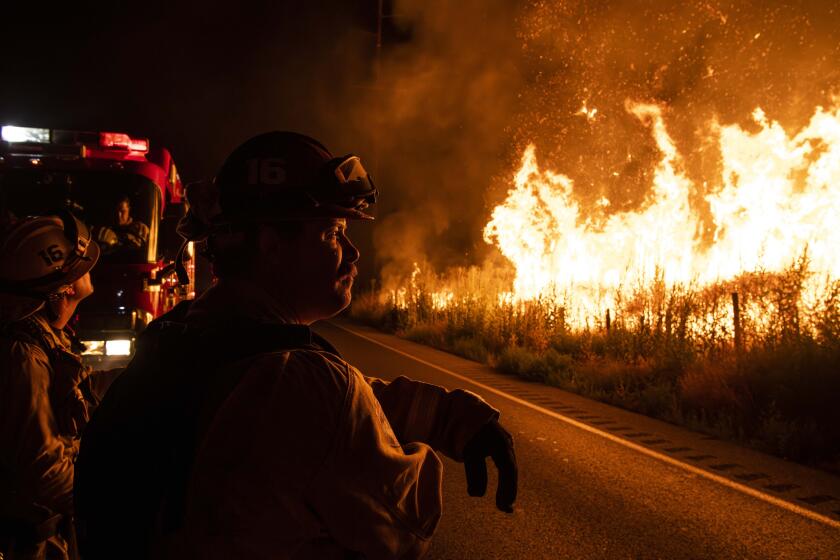Chance of strong atmospheric river storm grows, as does risk of mudslides in L.A. burn scars

- Share via
The second of back-to-back atmospheric rivers hit Southern California early Friday, bringing heavy rain to some parts of Los Angeles County and triggering floods, rockslides and minor debris flows in the Palisades burn scar.
But another storm that forecasters say is shaping up to be the strongest of the season so far is set to unleash even more rain across the region next week.
“People should be prepared that this is going to be the wettest period we’ve had so far this rain season,” said Ryan Kittell, a meteorologist with the National Weather Service in Oxnard. “So far, we’ve been very fortunate that all the storms we’ve had have been pretty light and pretty minimal as far as impacts are concerned. This storm will not be that.”
Heavy precipitation beginning late Thursday sent a torrent of debris and mud onto Pacific Coast Highway just north of Big Rock Drive in Malibu. California Department of Transportation crews hauled away about 10 truckloads of wet dirt and other debris, said Lauren Walike, a Caltrans spokesperson.
Last month’s Palisades fire — which charred more than 23,700 acres in Pacific Palisades and Malibu — had chewed through the vegetation on the hillside above the scenic highway, leaving it vulnerable to slides. An 8½-mile stretch of PCH from Chautauqua Boulevard in Los Angeles to Carbon Beach Terrace in Malibu remained closed Friday as rain in the area continued. It is not clear when the highway will reopen.
Rock debris was also reported along a three-mile section of Malibu Canyon Road between Civic Center Drive and Malibu Canyon Tunnel. The rain caused flooding along some Los Angeles freeways overnight into Friday morning, including the Broadway onramp to the northbound 101 Freeway, which left several cars stranded in the floodwaters, according to the National Weather Service.
The wet weather tapered off Friday afternoon, but it won’t be dry for long.
There is a 30% chance that “high amounts” of rain could fall between Feb. 12 and 15 in Los Angeles and Ventura counties, according to the weather service.

The chance of moderate amounts of rain now stands at 50% and there’s a 10% chance of low amounts. The highest threat for Los Angeles County is expected to be the night of Feb. 13 through the morning of Valentine’s Day, Kittell said.
Recent models have pointed to a higher risk — about a 60% chance — of heavy rain in San Luis Obispo and Santa Barbara counties. The system could trigger rainfall totals similar to those seen during the historic storm of Jan. 9, 2023, which forced the mass evacuation of Montecito and flooded the 101 Freeway. Two people in San Luis Obispo County, including a 5-year-old boy, were killed by floodwaters.
Powerful storms from late December 2022 through mid-January 2023 led to widespread evacuations and killed more than 20 people.
Kittell said residents — particularly those in places at risk of debris flows — should prepare for “the worst-case scenario.”
The scenario for high amounts of precipitation could mean intense rainfall rates of half an inch to an inch per hour or more, which could trigger debris flows or mudslides in recently burned areas.
Under this scenario, rain could arrive in a slow-moving storm that lasts for 12 to 24 hours or beyond and dump 2 to 4 inches or more on the coast and in the valleys, and 4 to 8 inches or more in the mountains and foothills.
“It’s still not certain, but it’s definitely stacking more and more chips onto that pretty high-impact event,” Kittell said.
The continued wet weather has prompted concerns from officials and residents living in the Eaton fire zone in Altadena and the Palisades fire burn scar in Malibu and Pacific Palisades.
Ahead of this week’s rain, Los Angeles County public works rushed to create additional capacity in debris basins and install concrete barriers, compost filter socks — a type of berm — and other items around burned homes to filter debris and prevent it from flowing into storm drains.
On Thursday, former Vice President Kamala Harris toured neighborhoods devastated by the Palisades fire, meeting with first responders and public works officials who were working in the area.
“To literally be on the ground here, you can smell the smoke that was here,” she told reporters after the tour. “You can feel the toxicity, frankly, of the environment. You can feel the energy of all the folks who are still here on the ground, doing the work of trying to make this area safe and then, at some point, provide a pathway to rebuilding.”
Recently burned areas like those in L.A. County are at risk for landslides in heavy rains, with soil no longer anchored by healthy vegetation. Making matters worse is that the heat from fire makes it harder for soil to absorb water, and ash tends to clog the soil.
As a result, water can start flowing on the soil’s surface downhill. That can trigger mudflows, where water rushes down only with mud, and more serious debris flows, where water can also pick up rocks, branches and sometimes massive boulders, traveling at speeds exceeding 35 mph. Both mudflows and debris flows are considered types of landslides.

Animated infographic shows a debris flow works
One of the worst debris flows in modern California history occurred when a river of mud and rock flowed through Montecito in January 2018, killing 23 people and destroying at least 130 homes. The area had been burned less than a month earlier in the Thomas fire. That blaze, one of California’s most destructive on record, burned 282,000 acres in Ventura and Santa Barbara counties and destroyed more than 1,000 structures.
Contributing to the severity of the Montecito debris flow was the failure of government officials to build bigger basins that could have made mudslides far less catastrophic, a Times investigation found. The report also found that Santa Barbara County failed to thoroughly empty the existing basins before the disaster, drastically reducing their capacity to trap debris.
The Times investigation found that the county’s flood control officials and Army Corps of Engineers had known for half a century that there were too few catchments and that the ones they had were far too small to stop the enormous debris flows the Santa Ynez Mountains were prone to produce.
The Times also found that Santa Barbara County released conflicting evacuation instructions, leaving the hardest-hit neighborhoods out of mandatory evacuation zones. It did not send out Amber Alert-style bulletins to cellphones until the mudslides had begun. By then, it was too late for residents to flee.
Between Thursday morning and 4 a.m. Friday, the storm had dropped 1.55 inches of rain in downtown Los Angeles, 1.75 inches in the Hollywood Reservoir, 1.88 inches in La Cañada Flintridge and 1.67 inches in east Pasadena.
Higher elevations saw even more precipitation. In Malibu Hills, 2.22 inches of rain fell and Warm Springs Camp received 3.08 inches.

Dry, gusty wind is expected to arrive Friday night from the northwest and northeast and last through Tuesday. Downtown L.A. and Long Beach could see gusts of about 14 mph; Thousand Oaks and Canoga Park, 21 mph; Santa Clarita, 26 mph; Lancaster, 37 mph; and Pyramid Lake, 45 mph. Fire weather conditions are expected to be minimal because of the recent rains.
Forecasters are hopeful that if next week’s rain delivers a significant soaking, it might be enough to move the region into a lower-risk category for wildfires. If that pans out, the “risk for any large fires would be fairly small for the rest of the winter into the spring seasons,” Kittell said.
The region has suffered a severe rain deficit so far this water year.
Downtown L.A. has received 1.94 inches of rain since the water year began Oct. 1. The average for this time of year — a little more than four months into the water year — is 7.8 inches. The annual average is 14.25 inches.
Downtown’s driest water year on record ended Sept. 30, 2007, when only 3.73 inches of rain fell. A bad fire season followed — with the largest blazes being the Zaca fire, which burned 240,000 acres in Santa Barbara County, and the Witch fire in San Diego County, which burned nearly 198,000 acres, destroyed 1,650 structures and killed two people.
The second-driest was for the water year that ended Sept. 30, 2018, when 4.72 inches of rain fell. That coincided with the Thomas fire and devastating Montecito debris flow that followed.
Despite the rain, drought conditions in Southern California worsened for yet another week, with much of the region now considered to be in “extreme drought” conditions, only the second-worse category tracked by the U.S. Drought Mitigation Center.
The center’s latest map, released Thursday, shows nearly all of coastal Southern California, including most of Los Angeles and Ventura counties and all of Orange and San Diego counties, in “extreme drought.” Much of the rest of the region is considered to be in severe drought.
The rain has not brought enough moisture to stop drought conditions, said Lindsay Johnson, a climatologist with the center who was author of the latest map. She said the center’s analysis takes into account rainfall but also soil moisture, snowpack, fire danger and other hydrological metrics.
“The longer it’s been dry, the more rain it takes to come back to normal, generally speaking,” Johnson said. “There’s a lot of deficit to make up.”
Heavy rain across the northern section of the state this week prompted officials to begin releasing water from Shasta Dam into the Sacramento River. Two other reservoirs are also releasing water, the Bureau of Reclamation announced Thursday.
Shasta Lake, California’s largest reservoir, has risen more than 22 feet since Jan. 31, according to the agency.
“Concurrently, the federal pumps in the Sacramento-San Joaquin Bay-Delta are currently operating at maximum capacity and storing water in San Luis Reservoir to support south-of-Delta delivery to farms, communities and wildlife refuges when needed later this year,” the agency wrote in a news release.
Shasta Lake is at 134% of its historical average for this time of year.
Lake Oroville — California’s second-largest reservoir and the keystone to the State Water Project, which supplies water to Southern California, the San Joaquin Valley and the San Francisco Bay Area — is at 137% of its historical average.
San Luis Reservoir, the fifth-largest reservoir in California, is at 121% of its historical average. The reservoir, in Merced County, stores water from the Sacramento-San Joaquin River Delta to be delivered later to Southern California, the San Joaquin Valley, the Central Coast and Silicon Valley.
The northern Sierra has accumulated 37.4 inches of precipitation since the water year began on Oct. 1. That’s 128% of average for this point in the season — an improvement after a dry January, when accumulated precipitation dipped below the average for the first time in months.
Times staff writer Grace Toohey contributed to this report
More to Read
Sign up for Essential California
The most important California stories and recommendations in your inbox every morning.
You may occasionally receive promotional content from the Los Angeles Times.













